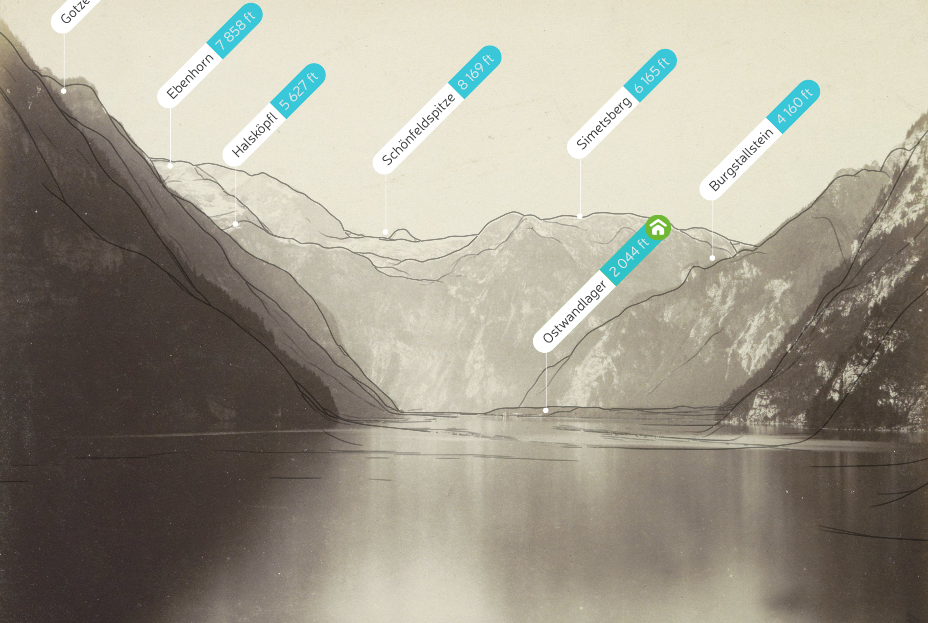First Steps to Getting Started in Open Source Research
Open source research has “come of age”, according to a recent article published by The Economist. What was once the niche realm of a relatively small number of individuals with free time and obsessive internet habits is now informing research and journalism in a wide range of fields and institutions. It’s hard to imagine a better time to roll up your sleeves and set off on the path of the open source researcher.
The promise of open source research is that anyone — not just journalists or researchers at select institutions — can contribute to investigations that uncover wrongdoing and hold perpetrators of crimes and atrocities to account.
When we say “anyone”, we mean anyone: if you’ve an internet connection, free time, and a stubborn commitment to getting the facts right, then you too, can be an open source researcher.
Getting started in open source research can be daunting, especially if the field is completely new to you. But there’s no reason to fear: this guide will cover concrete steps that you can take to develop skills, discover communities based on your interests, and eventually lend a helping hand to important research.
By following these steps, you’ll learn where to find open source researchers, how to observe and learn from their work, and how to practice the new skills that you’ll develop.
1. Take Stock of your Skills and Interests
Are you interested in a particular conflict? Or do you love solving puzzles, which could translate to geolocating images? Do you have a programming background, or knowledge of several languages? Or are you fascinated by military machinery and equipment?
Having an idea of what topics interest you and what you’re good at will help you find other researchers on social media whose work you might want to follow, and may eventually use to inform for your own.
If you’re not sure how your skills and interests might translate to this field, then don’t worry: that just means that you’ll have more to discover.
2. Get on Twitter
The importance of this step cannot be overstated.
Twitter is the primary medium for identifying, debating, and disseminating open source research. It’s full of practitioners who are eager to engage in discussions with others about best methods and practices, and to share their own work and that of others. Having a Twitter account will allow you to follow researchers so that you can learn from their work, as well as ask questions and engage in discussions with like-minded researchers.
If you’re security conscious or have any reason to want to be anonymous, you can easily set up a Twitter account that doesn’t contain your real name or other personal information. The open source research community welcomes anonymous accounts, and operating anonymously doesn’t have any negative connotations (though you may find that eventually you’ll have to reveal your identity if you get approached with publication offers or job opportunities).
If you’re still Twitter-averse, remember that you don’t have to post anything — ever. Twitter’s primary purpose can be to show you what other researchers are saying and publishing, so you don’t ever have to interact with anyone unless you want to.
3. Find Your People (and Put Them on a List)
Once you’re on Twitter, you’ll want to follow lots of open source researchers. This will allow you to see what topics the field is interested in, which organisations tend to focus on which issues, and which methods they employ in their research. More importantly, you’ll be able to learn directly from the experts about methods, tools, and best practices.
If you’ve just learned about the world of open source research, it might be a good idea to cast a wide net and follow researchers at established institutions like the New York Times Visual Investigations, Bellingcat, or the Washington Post Visual Forensics team.
One easy way to find open source researchers is to follow Twitter lists. Any user can create a list of accounts, and some — like Malachy Browne of the New York Times’ Visual Investigations Team — have made those lists available. His “OOSI List” contains more than 200 open source researchers whose work you can keep up with by following the list.
OOSI, OSINT or OSI — What’s in a name?
Some people use the term “online open source investigations” (OOSI), while others use “open source investigations” (OSI), but the term that’s been around the longest and is used most often on social media is “open source intelligence” (OSINT). These terms are usually used interchangeably, but there are some differences among them that you might want to consider.
The difference between OOSI and OSI is in the name: while OOSI refers to investigations that only use online sources, you would use OSI to describe an investigation that also used offline open sources.
Some who use OOSI or OSI instead of OSINT do so because they feel that the name “OSINT” has direct connotations to intelligence agencies. For these agencies, OSINT is part of an ecosystem of intelligence sources that includes HUMINT (human intelligence), SOCMINT (social media intelligence), IMINT (imagery intelligence), and others. While some independent researchers might be justifiably uncomfortable with that connotation, the term is still widely used and is probably the most recognised.
In any case, we’d recommend using all of these search terms in order to broaden the resources at your disposal.
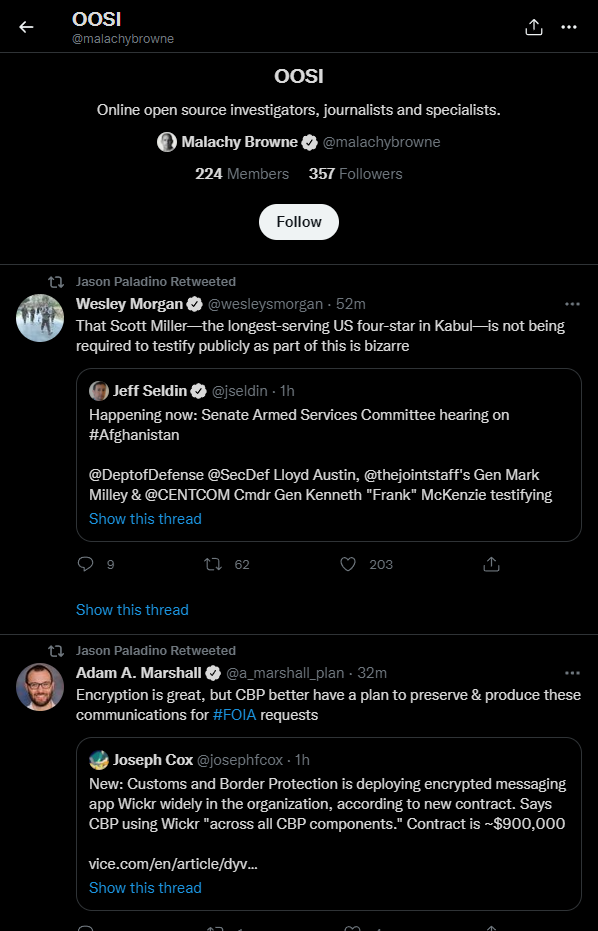
Malachy Browne’s OOSI Twitter List has over 200 researchers and organisations whose work you’re about to discover.
Other useful Twitter lists of researchers include:
- Gisela Pérez de Acha’s “OSINTers”
- Rawan Shaif’s “OSINT”
- Bianca Britton’s “Open Source”
- Julia Bayer’s “OSINT research verify”
As time goes by and you become more familiar with the field, you’ll start to notice how wide and varied it is. On some corners you’ll find researchers who focus exclusively on identifying weapons seen on videos from conflict zones; on some you’ll see people who dedicate their time to tracking aircraft or ships, while in others you’ll find expert geolocators. You might decide that you’ll want to create your own list of niche researchers, which you can do by following the instructions in this guide.
4. Find Community Branches
Open source researchers and enthusiasts tend to spend lots of time online, which means that they’re likely to be hanging out in digital spaces besides Twitter.
Discord is a popular messaging app on which several open source communities have chosen to set up base. These communities resemble the chatrooms of the early internet, and are called “servers” in Discord lingo.
Bellingcat’s Discord server is located here. Anyone can join and share tools, ask questions, and collaborate on research projects. The server is divided into topics where users are welcomed to post relevant content for discussion.
Other open source communities with Discord servers that you should check out are:
- The OSINT Curious Project: Community hub for OSINT Curious, a website dedicated to sharing news and educational information about open source research.
- Project OWL: At any given moment, you’re likely to find thousands of members online in this sprawling server dedicated to every imaginable facet of open source research.
- Bridaga Osint: This server is dedicated to sharing information and resources for the Spanish-speaking community.
There are many more open source-focused Discord servers out there, so never stop looking. Remember that open source research is a collaborative effort, so don’t be afraid to get out there and network.
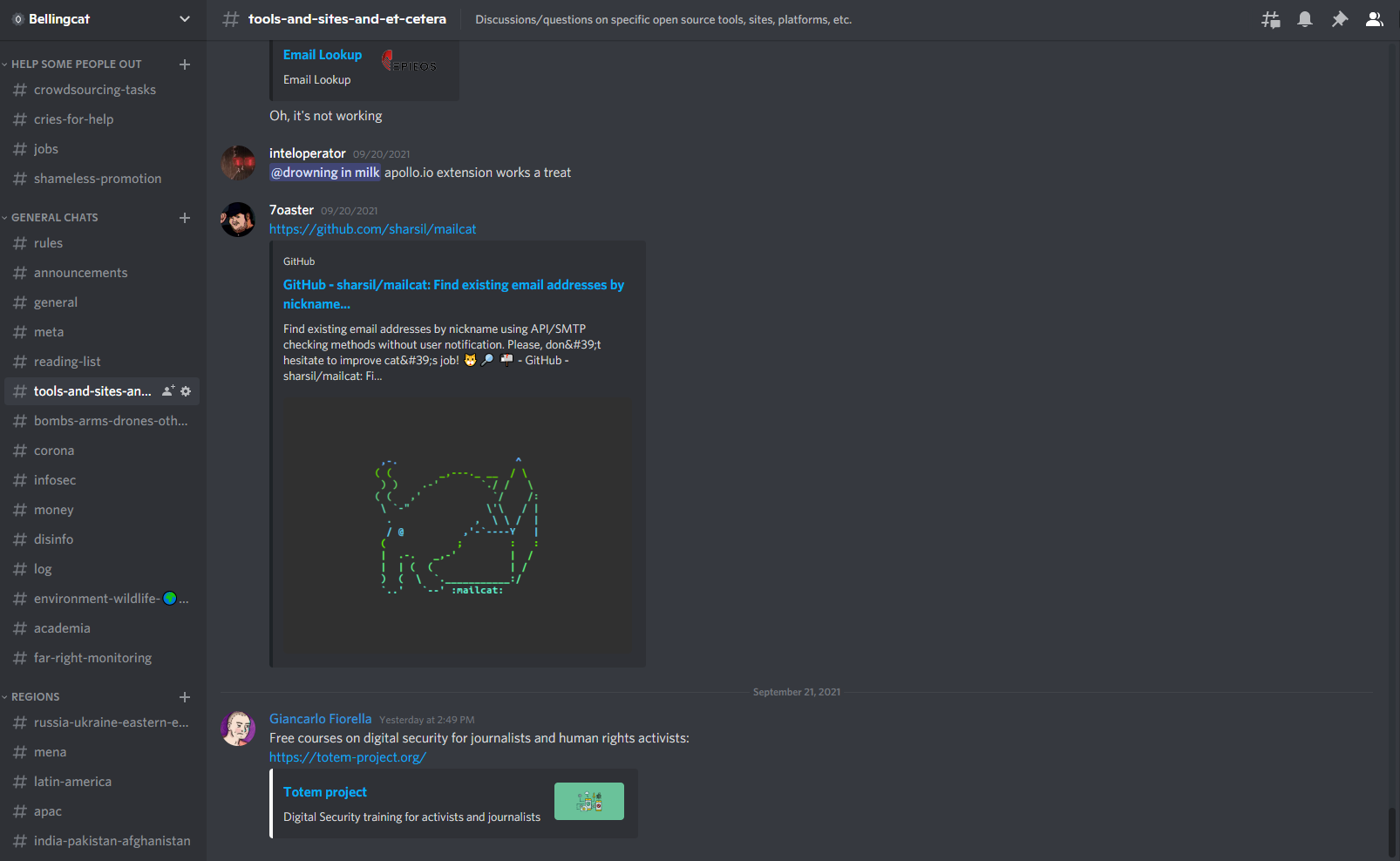
Discord channels are a great place to meet and chat with others interested in research. In the Bellingcat Discord server, there’s a channel dedicated to sharing research tools and resources.
Reddit also hosts open source research communities, including r/Bellingcat, a community-run subreddit. r/OSINT boasts over 26,000 members, making it an active hub of questions and answers on all things related to the field.
The r/TraceAnObject subreddit is dedicated to bringing together people who want to help EUROPOL with its #TraceAnObject campaign and the FBI’s Endangered Child Alert Program. The campaign allows law enforcement to request assistance from the public with identifying individuals, objects and locations seen in child sexual abuse images. Spending time in these subreddits will allow you not only to potentially assist in the rescue of a child, but in the process, to develop your open source research skills. Bellingcat’s own Carlos Gonzales got started in open source research by helping out with these two campaigns part-time.
Joining these kinds of spaces and interacting with fellow enthusiasts and researchers might result in opportunities for you to contribute to important projects, or even inspire you to launch your own.
5. Observe, Learn, and Practice
Now that you’ve got a sense for what the community looks like, where researchers hang out and who’s working on what, you can start to dedicate time to developing and practicing the new skills you’ll be picking up.
One excellent way to practice research skills is by trying out @Quiztime challenges on Twitter. This account posts daily images and challenges you to find out exactly where they were taken.
Sometimes the quizzes also build off an established geolocation for the image, asking you to determine what an object in the image is or when it was taken.
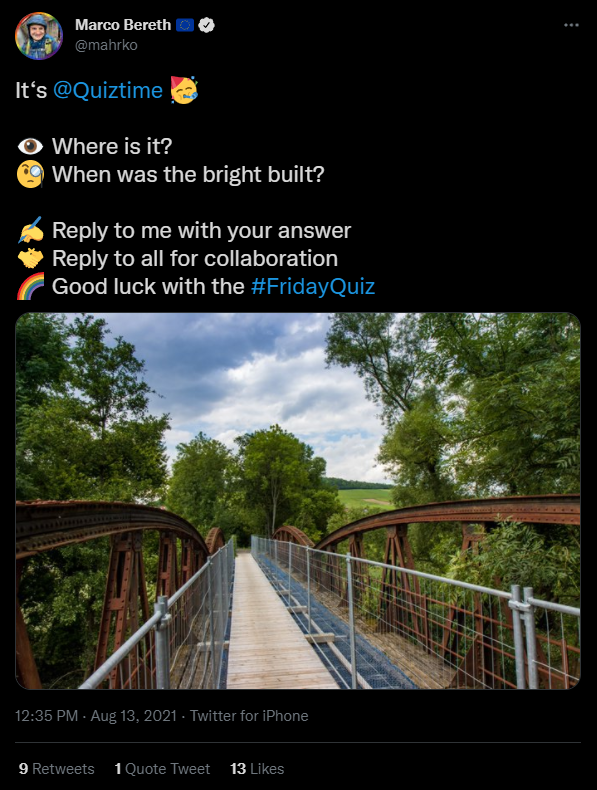
This Quiztime challenge asks you to determine where this bridge is located and when it was built. How would you go about doing that?
Geolocation is not the only skill that you could develop by doing Quiztime challenges.
With the example above in mind, how could you narrow down the number of search areas, from “anywhere on the planet” to a particular country or region? How might you determine what kind of bridge that was? Would a reverse image search work, or would you have to dig deeper into bridge design? Are there any bridge architecture databases or other resources that you could draw from? Google Maps would be the starting place for the geolocation, but many places in the world don’t have Google Street View. If that’s the case for the place where this bridge is located, how else might you find street-level imagery of this place?
These are just some of the questions that you might ask yourself if you were working to solve this challenge, and they’re the same kinds of questions that you might ask yourself if you were working on an open source project to verify images of atrocities in a conflict zone.
In a similar vein, Geoguessr is a geolocation game that is popular in the open source community (both Bellingcat and OSINT Curious, to name two examples, stream Geoguessr games on Twitch). The game drops you into a Google Streetview image, and it’s your job to guess exactly where the picture was taken. After each guess, you’re given points. The closer your guess is to the actual spot, the more points you get.
You can play by different sets of rules, including no Googling for information or not moving from the spot where you land. These make the game well worth replaying and allow you to tweak its difficulty to your liking.
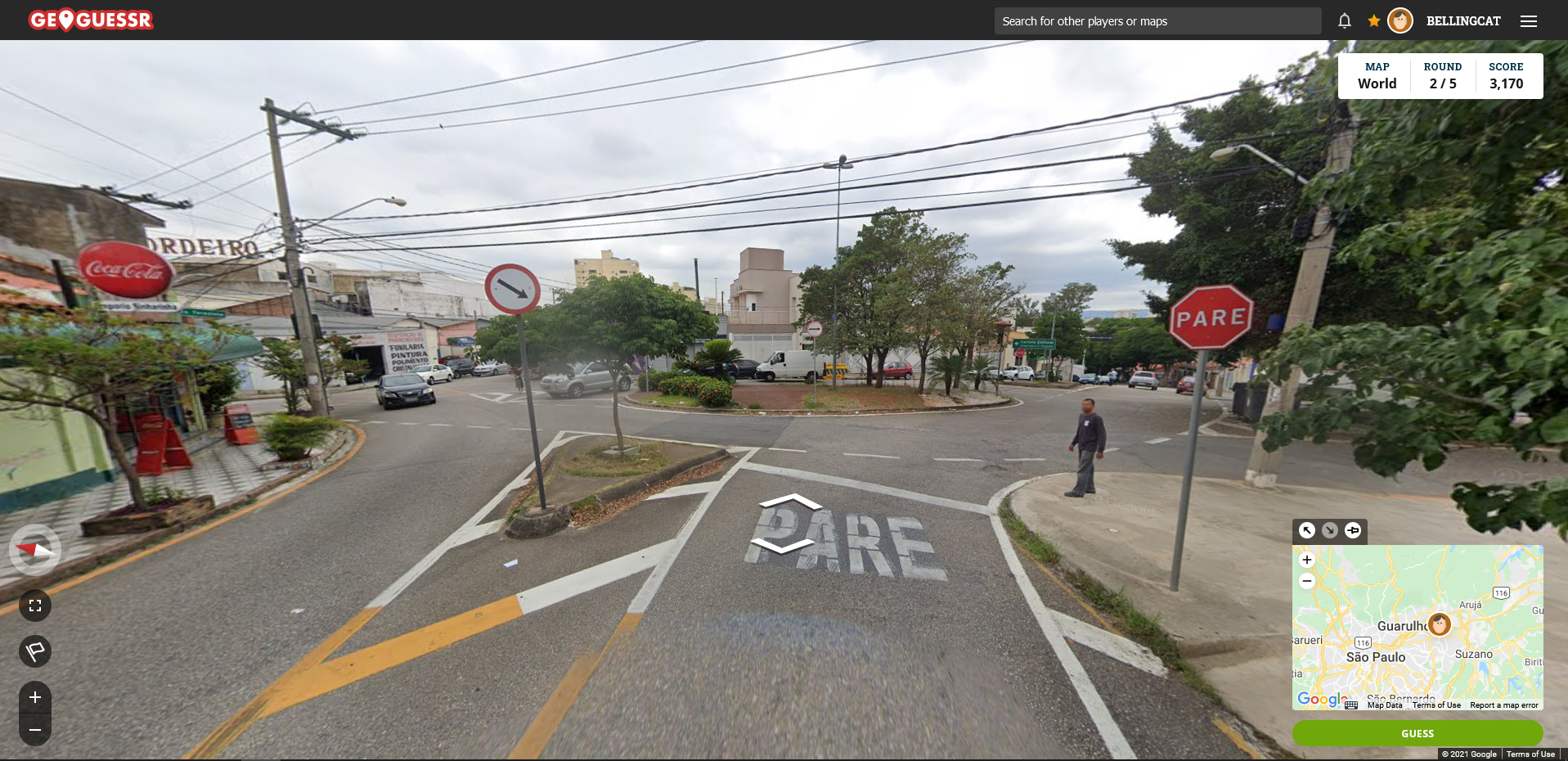
You could spend hours honing your geolocation skills on Geoguessr.
At this point, you can start putting some of these steps together. For example, you might decide that you want to collaborate on a Quiztime challenge with other Twitter users, or set up a Geoguessr Game Night with people you met in the Bellingcat Discord server.
You might also consider joining events like Trace Lab’s Search Party CTF, where four-person teams compete to find information about missing persons (you can read more about what exactly Trace Labs does and why in their “About” page). By participating in these events you’d not only be potentially helping find a missing person, but you’d also have the chance to work (and learn from) other OSI enthusiasts by putting your skills to practice in a team setting.
Now that you’re all set up, here are a few more ideas to get you on your way.
Bookmark Community Resources
One of the great characteristics of the open source research community is its willingness to share knowledge. This knowledge-sharing sometimes takes the form of newsletters and community resource pages that feature tools and research projects for you to explore.
Sector035’s Week in OSINT is a weekly newsletter that looks back over the previous seven days in the world of open source research. The newsletter covers everything from new tools that the community has discovered or developed, to new articles and other resources that have just been published. Week in OSINT delivers the best and newest in open source research to your inbox, making it a guaranteed way to learn the ropes of the field.
Bellingcat’s Guides and Resources section includes articles that focus on methodology. The purpose of the articles in this section is to show the reader a new tool or technique, and to provide an example of how it might be used in a research project. We also have a Digital Investigation Toolkit which is updated regularly with new tools.
Mentioned earlier for their Discord channel, OSINT Curious is a community of open source researchers who produce podcasts and live stream everything open source. They’re constantly putting out new content, so you’ll never be short on things to learn.
Individual researchers also take the initiative to collect resources and make them available to the public, like hatless1der’s Ultimate OSINT Collection, and the OSINT Hub. As you become familiar with the research landscape on Twitter, you’ll come to find individuals who, on their own initiative, share these kinds of useful resources with the community.
If you’re interested in learning about every single detail of how to put an open source research project together then make sure to bookmark the Berkeley Protocol on Digital Open Source Investigations. This document is a one-stop resource for all questions related to workflow, from ethical and legal considerations of research to security awareness and data collection and analysis. The Protocol was put together by an impressive team of some of the brightest minds in the field, and was spearheaded by the Human Rights Centre at the University of California, Berkeley.
Be Patient — and Have Fun
Chances are that you’re going to find out pretty quickly that geolocation, chronolocation, determining what objects are in images, or any of the other skills that you’ve chosen to develop are difficult to master. You might find that you’re not able to solve @Quiztime challenges, or that the conversations that people are having in your Discord server involve topics and techniques that you’ve never heard about.
Do not be discouraged. Be patient.
None of us who do this for a living had any of these skills on the first day, the first week, or even the first month (importantly, many or even most seasoned researchers don’t do this for a living at all). In fact, ask any open source researcher and they’ll tell you that they’re still learning new things every single day, and that there are some areas of the field in which they’re novices, too (for example, I barely know the first thing about Python).
Do not be discouraged if you feel like the pace at which you’re learning is slow. As long as you’re having fun learning, then you’re sure to make progress. If you stick with it, you’ll look back in a month or a year on your first day and realise how far you’ve come!
Remember to Take Care
As you set off on your journey as an open source researcher, it is important to be aware that you may be exposed to traumatic materials depending on the topics you follow and events you decide to investigate. This may come in the form of imagery from conflict zones, environmental destruction or human tragedy in the aftermath of natural disasters. Because we’re all different, we all have different triggers and thresholds for working with traumatic materials.
It’s important that you know that there are online resources to help you learn about trauma and how to build resilience. The Dart Centre for Journalism & Trauma is dedicated to providing journalists and researchers with resources related to working with trauma, including practical guides for working with traumatic imagery. Don’t wait until you’re in distress to check out these resources. Become familiar with them and implement their suggestions into your workflow to help ensure your mental health and well-being.
Don’t Just Take My Word for It
I’ve asked other open source researchers to share their own advice for people who are getting started in the field. Here’s what they had to say:
“Don’t worry about the OSINT tricks, or being very good at geolocating. You’ll get the hang of those. But be very, very, curious and creative. Be the person that keeps pulling that little thread until you know what’s on the other side.”
— Annique Mossou (Investigator, Bellingcat)
“Enjoy yourself. And not in some wishy-washy general advice way: make sure you’re doing something you’re interested in.”
— Nick Waters (Investigator, Bellingcat)
“Creativity, perseverance and determination rule above any toolkit available. Take your time to think about how to solve the problem. Follow your instinct, but record/archive what you are doing. Provide feedback to yourself to correct your track and avoid rabbit holes. Believe and enjoy what you are doing. Don’t hesitate to ask the open source community when you don’t know something. There are incredibly good people out there to help and guide you.”
— Carlos Gonzales (Investigator, Bellingcat)
“Don’t try to become an expert in all types of OSINT at first: it can be too vast and overwhelming. Pick one type that interests you and develop it into a specialism. Tools are the flashier side of OSINT, but the real skill is methodology. So, look up successful examples of OSINT methodology to learn from, but also think about how you could have gone about investigating that particular case.”
— Manisha Ganguly (Journalist & OSINT documentary producer for BBC)
“OSINT is about curiosity, creativity, sharing and collaborating as well as constant learning. The beauty about the OSINT community is that everyone brings in a specific technical skill, a passion for something like bird watching, or a special knowledge on a topic like architecture. If you bring in this mindset then trust your gut-feeling and your skill set and get started at @Quiztime.”
— Julia Bayer (Investigative journalist, DW News, and founder of Quiztime)
There’s a lot to be said for the insights that can be gleaned with OSINT to make a genuine difference to the world around you. A few principles: Don’t be afraid to ask questions of others or to make mistakes as you learn. Set specific targets for your projects if you can. Archive everything that you may need. Don’t take what others say as fact, check it yourself. Always seek context & don’t rush to be the first to post about a finding.
— Calibre Obscura (Weapons and non-state armed groups analyst)
Get on Twitter, follow the OSI experts in the domains you’re interested in, and message them to understand their work and offer your help. That’s how most of us joined the community.
— Aliaume Leroy (Open Source Investigator & Producer, BBC)
Gear Up to be a Bellingcat Volunteer
Now that you’ve got an idea of how to get started in open source research, how about setting a goal?
By following the steps in this guide, you can spend the next few months learning about open source research in preparation for the launch of our Volunteer Platform. Due to be launched in 2022, the platform will allow you to contribute to various open source research projects. You’ll be able to register on the platform, login, volunteer for tasks, and work on them together with other volunteers.
Keep your eyes on our Twitter account and on our website, where we’ll post instructions on how to get involved once the platform launches. We hope to see you there.


